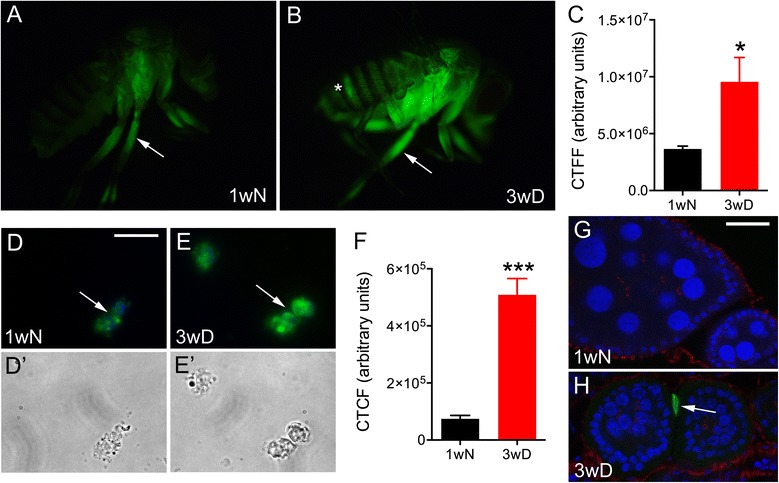Fig. 6.

Tissue specific JAK/STAT signaling in diapausing flies. The Stat92E reporter 10xStat92E-GFP expression in the whole body is compared between control flies (1wN) (a) and flies in diapause conditions (3wD) (b) and shows an increased fluorescence in 3wD, as quantified in (c) with corrected total fly fluorescence (CTFF). The statistical significance was verified by Welch’s unpaired t-test, * p < 0.05, n = 6 (error bars show standard error of the mean). In (a) and (b) arrows point to hemocytes that accumulated in the legs of the fly, which largely contributes to the fluorescence signal, and the asterisk in B indicates GFP signal in the ovaries. d and e Hemocytes exhibit a strong accumulation of the 10xStat92E-GFP signal upon diapause, 3wD (e) compared to controls, 1wN (d). In these figures green label is 10xStat92E-GFP, and blue label hemocyte nuclei stained with DAPI. E´ and D´ The corresponding hemocytes displayed in bright field. The scale bar corresponds to 20 μm. f Corrected total cell fluorescence (CTCF) for diapause and control hemocytes is calculated as an average from n = 15, statistical significance verified by Welch’s unpaired t-test, ***, p < 0.001. Error bars show standard error of the mean. g and h Portions of ovaries from control (1wN) and diapausing (3wD) flies. In diapausing flies there is an increased expression of the 10xStat92E-GFP reporter (green) in polar cells of ovaries (arrow in h), which is not detectable in directly developing ovaries of control flies (g). Blue label, nuclei stained with DAPI; red label phalloidin-TRITC. Scale bars: D, E 50 μm, G, H 25 μm
